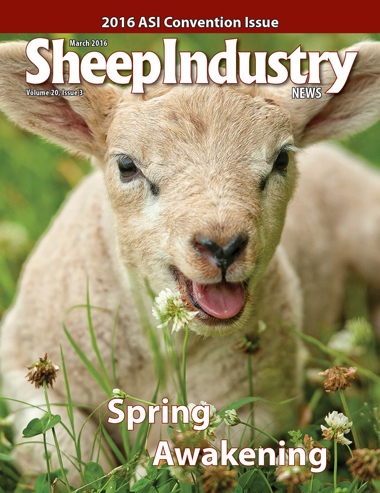
- March 2016
- President’s Notes
- 2016 ASI Convention
- The Strength of a United Voice
- State Execs Benefit from Media Training
- Award Winners Recognized
- Producer Panel Praises EBVs
- PERC Hears Survey Results
- Tips on Preparing for VFD
- Providing Consistent, Quality Lamb
- Let’s Grow Sets New Priorities
- Allotment Records Are Important
- Legislative Council Busy in 2015
- Next Generation Makes Plans
- Arizona Ag Tour
- Optimism For Wool Industry
- Make It With Wool Winners
- Working Dog Liability Insurance
- Seeking Young Producer for Tri-Lamb
- Wolf Testifies on Behalf of Sheep
- Sheep Inventory Up Again
- Use NSIP Data To Improve Lambing Rates
- Market Report
Let’s Grow Sets New Priorities
KYLE PARTAIN
Sheep Industry News Editor
Hitting one of three new target priorities will increase your chances of receiving a Let’s Grow grant in the third round of funding this spring.
The Let’s Grow Committee set the new target priorities during its meeting at the ASI convention in Scottsdale. Those priorities are as follows:
• The development of producer groups to increase cooperation
between producers with similar production systems.
• Increase the adoption of out of season lambing to help distribute supply more evenly and thus help decrease the seasonality of lamb production.
• Development of business tools to assist sheep ranchers/producers.
The committee was certainly influenced to place a high priority on out of season lambing after hearing a presentation from Richard Ehrhardt, Ph.D., the small ruminant extension specialist with Michigan State University.
While there’s no doubt out of season breeding can generate additional income and provide fresh lamb at ideal times (such as Easter), the question is how a producer goes about the process of breeding sheep during off times.
Ehrhardt said sheep can be “fooled” into lambing any time of the year at a peak lambing rate by controlling light exposure. He also stressed that breeds that evolved closer to the equator are less seasonal than other breeds when it comes to breeding. Preliminary studies have also shown success in off season breeding with Dorset and Romanov breeds.
There are additional costs for producers to keep in mind with out of season breeding. Factors such as nutrition, infrastructure, labor and flock maintenance are important to consider.
Committee members also heard updates on many of the programs that received grants in the first round of funding in fall 2015. One success story comes from Kentucky, where Let’s Grow funded a grant for small ruminant mentor training. In approving the grant, ASI identified Kentucky as a potential growth state. Data released by USDA in late January showed a 10 percent increase in total sheep numbers in the state – the second-largest increase in the United States from 2015 to 2016.
Second round grants were awarded in December 2015 and many of those projects are already underway, as well. Applications for third round funding are now available at SheepUSA.org and are due in by April 18. Grants will be awarded in May.

